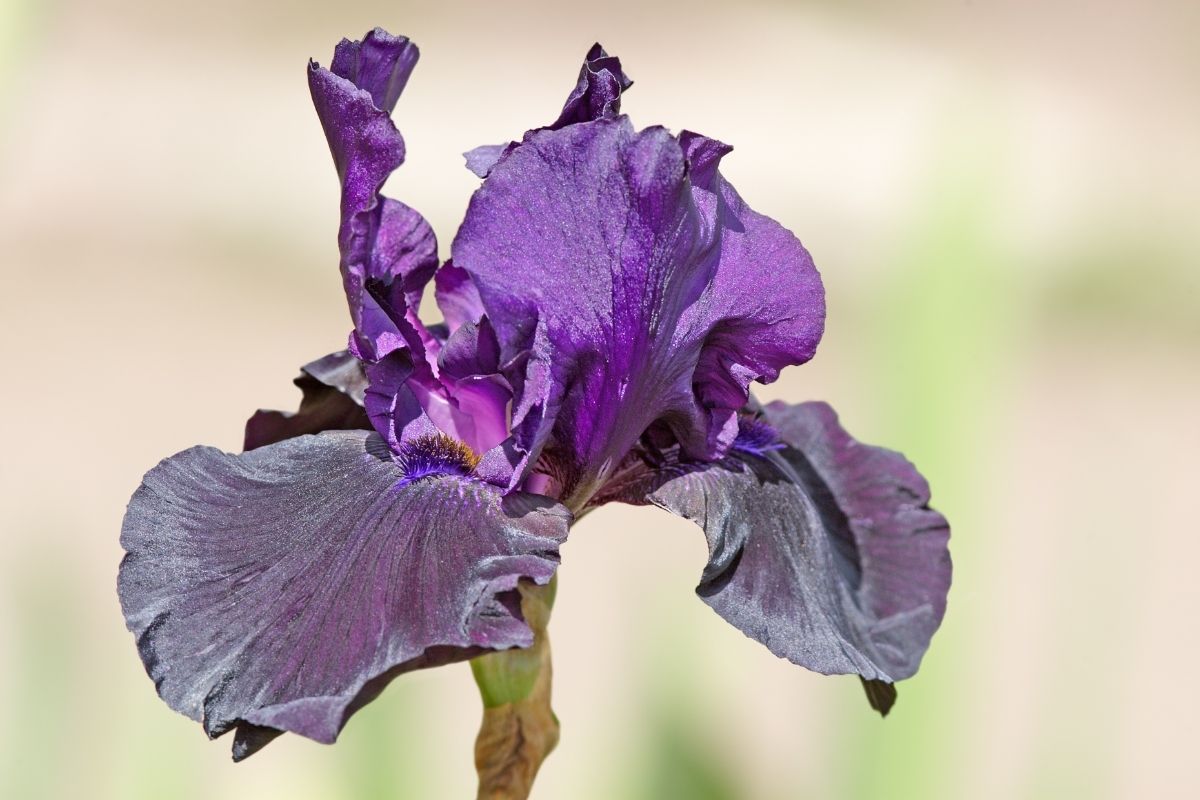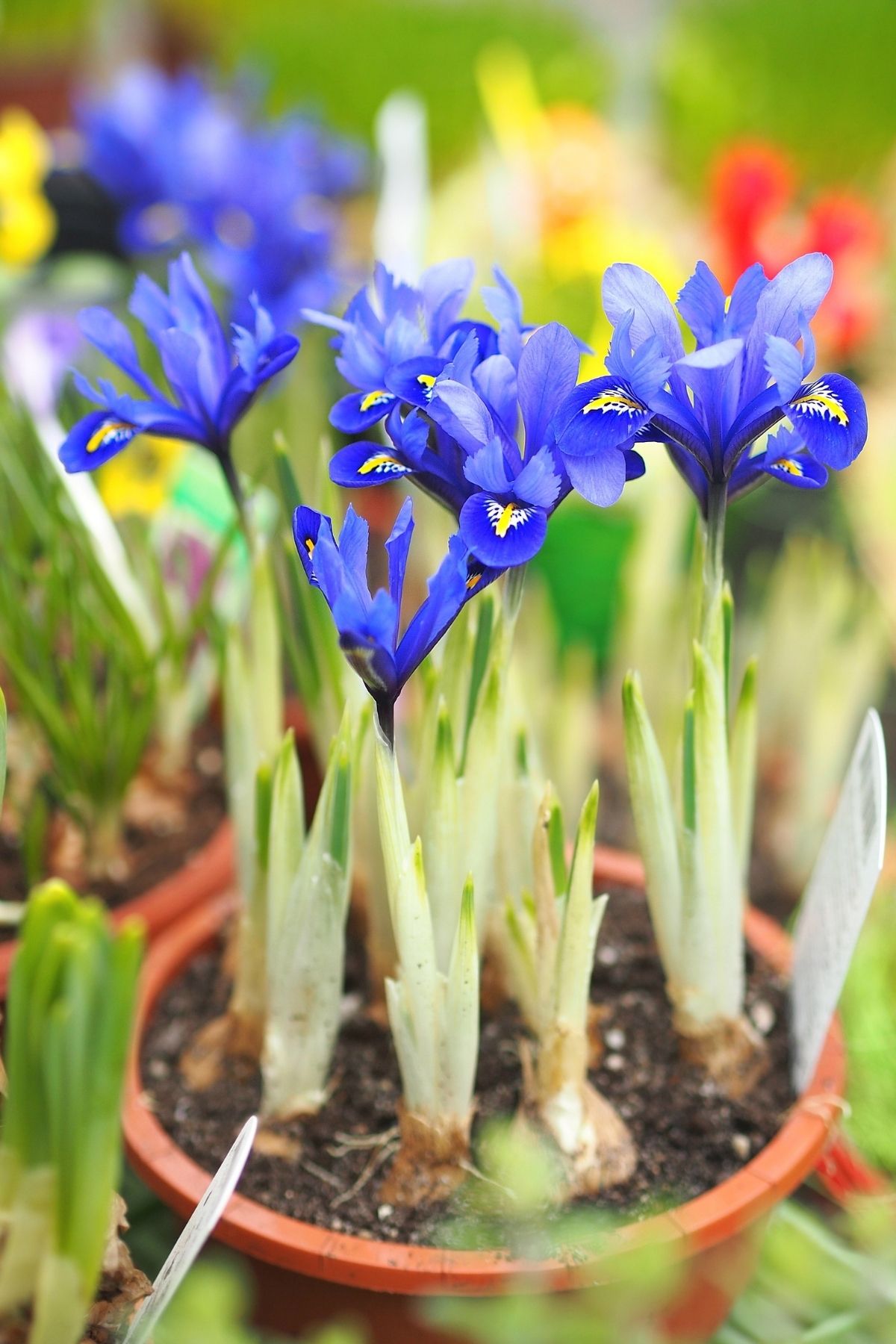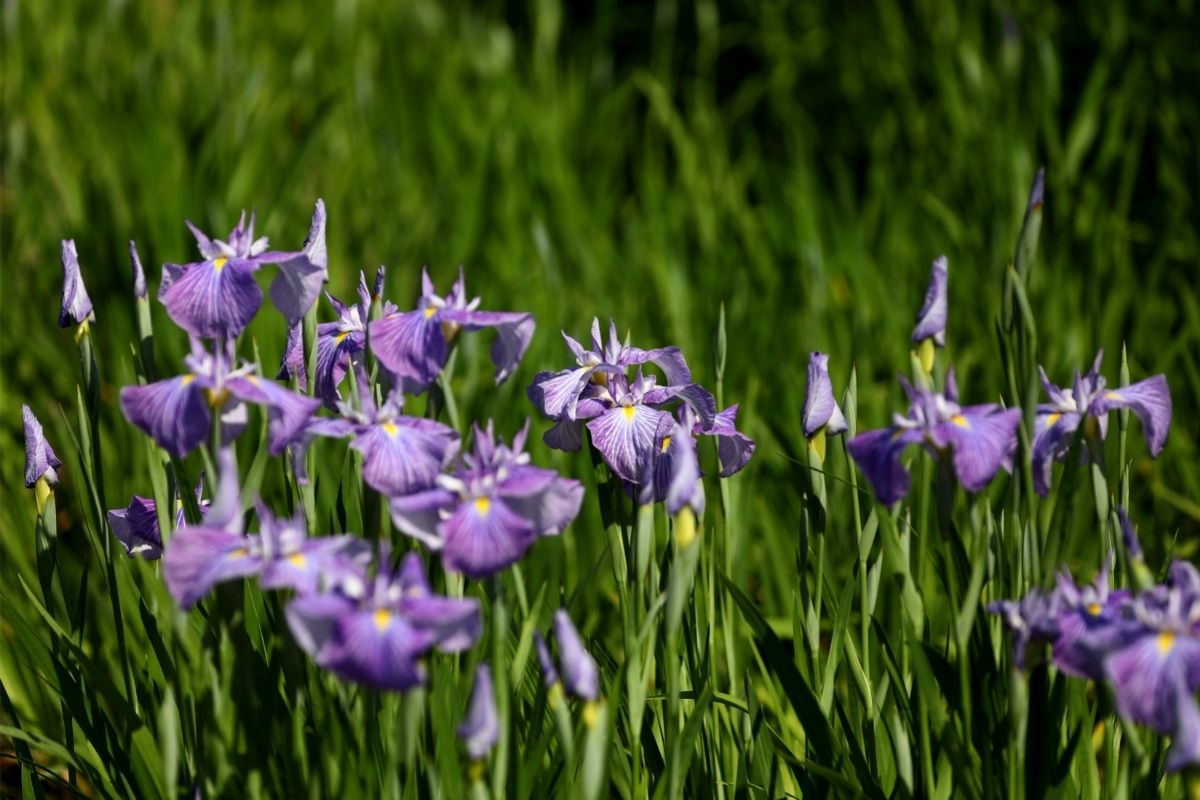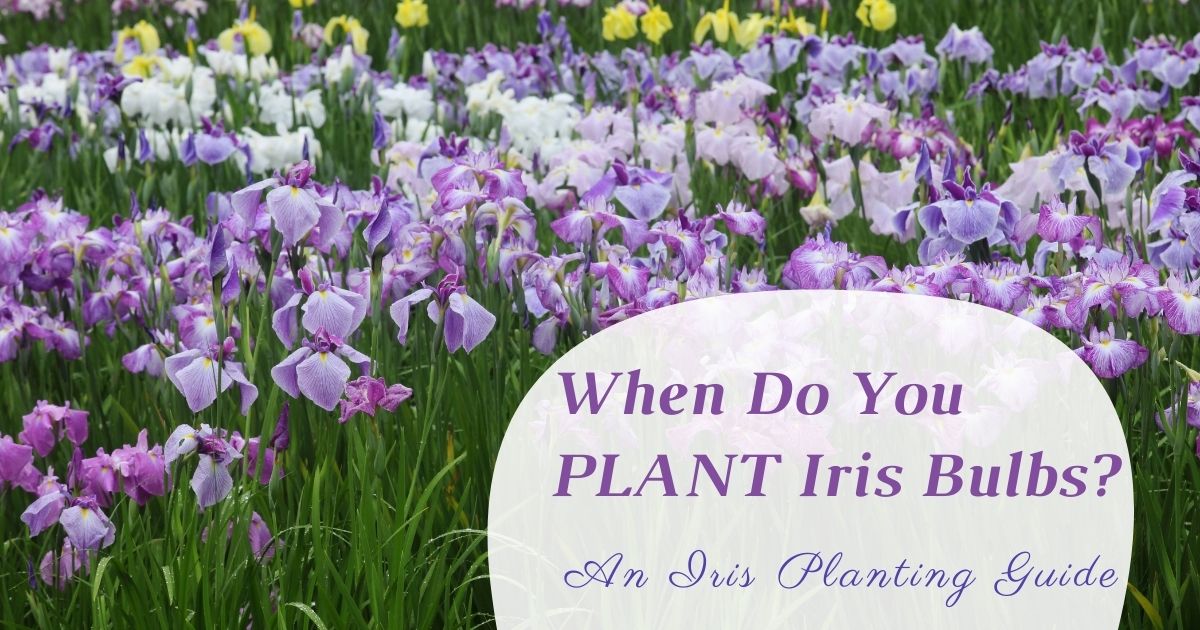When Do Irises Bloom?
When do you plant iris bulbs? Plant irises in late summer or early autumn, when overnight temperatures are 40°F to 50°F ( 4°C to 10°C) or higher. This gives them plenty of time to settle in before the winter arrives. It’s better to plant them closer to fall because tall bearded iris bulbs go dormant early to mid-summer.
From early spring to early summer, several bearded varieties bloom.
When do you Plant Iris Bulbs?
The time to plant iris bulbs varies depending on the environment and species. Still, for spring blooming flowers in the United States Department of Agriculture (USDA) plant hardiness zones 8 to 10, July through September or October is the optimal time to do so. However, warm, dry weather may allow bulb plantings into December and January in Mediterranean climates.
Bearded Iris Plant
Bearded iris bulbs range in size from micro dwarf to “tall” at about 41 in (104 cm) tall, with various sizes in between. Flowers emerge from bulbs or rhizomes, thick, tuberous roots that store nutrients that the plant’s semi-evergreen foliage produces.
The stems of bulbs and rhizomatous irises must get positioned so that feeder roots develop downward into the soil when you plant them.
The best period to grow bearded iris bulbs is from July to September when temperatures are above 40 °F (4 °C). Iris rhizomes can develop before the first frost by planting in the fall. Plant indoor-grown iris bulbs in the spring or summer.

Beardless Iris
In the spring, bearded and beardless irises bloom simultaneously. Except for Pacific Coast Native irises (PNC), which bloom first, beardless varieties bloom after fading the bearded flowers. Fibrous-rooted rhizomes are also present in bearded irises, and you must plant their tops slightly below the soil level.
Before heavy rains saturate the soil, plant beardless iris bulbs in the fall, just like bearded varieties, especially in Mediterranean climate zones. Early spring is an excellent time to plant beardless irises. They may, however, take a year to root and bloom.
Planting Bulbs in USDA Zones 8 to 10
Bulbs planted in the fall in USDA zone 8 establish quickly on warm, organically mulched, well-draining soils with a pH of 6.8 to 7.0. Plant iris bulbs and other flowering bulbs grow in Mediterranean conditions but are hardy to cooler climates in zones 9 and 10 from mid-August to December or mid-October to late January.
For example, in numerous forms and colors, Dutch iris bulbs (I. x hollandica) are hardy to -10 °F (- 23.33°C). Plant Dutch iris bulbs in late January for spring blooms in Mediterranean regions.
How to Plant Iris Bulbs
Iris Planting Guide
- Plant the rhizome horizontally while exposing the top for bare-root irises. It should be below the soil surface in hot-summer settings.
- Depending on their size, plant rhizomes individually or in groups of three, 1 to 2 ft (0.3 to 0.6 m) apart.
- Dig a shallow hole with a diameter of 10 in (25 cm) and a depth of 4 in (10 cm). Create a dirt ridge in the center and set the rhizome on it, spreading roots on both sides. Fill the hole with earth and gently firm it, leaving a portion of the rhizome and leaf exposed.
- Tip: It’s all too easy to plant irises too profoundly. In warmer climates, expose iris rhizomes partially to the elements or lightly covered with soil. They won’t thrive if you bury them too deeply.
- Do not use mulch around the rhizome because it encourages rot.
- Thoroughly water the area.
How Deep do you Plant Iris Bulbs?
Elegant Dutch iris bulbs come in various colors, including royal blue, lilac, bronze, red, and yellow, and are a favorite in spring bouquets. If you’re wondering how deep to plant iris bulbs, find a sunny location with well-drained soil for the best show, and plant the bulbs between September and December before the ground freezes.
But how deep should you plant iris bulbs? Plant the bulbs in holes 4 in (10 cm) deep and 2 in – 4 in (5 cm-10 cm) apart. Dig a trench, place the bulbs, and cover with soil and water thoroughly for more significant groupings.
How Deep do you Plant Bearded Iris Bulbs?
The magnificently bearded iris grows from a rhizome, a lumpy-looking root mass that prefers to sit right on the soil’s surface. That is the depth at which you should plant bearded iris bulbs. Plant the rhizomes in a well-drained, sunny location in late summer. You need to plant it with visible tops and enough water to encourage the roots to grow.
Bearded irises quickly spread, generating enormous clumps that you must separate after a few years to encourage new blooms. Cut the leaves back to a few inches after flowering, dig up the rhizomes, and split them with a knife. Replant the portions so that the crowns of the plants are visible. You’ll appreciate them as cut flowers or for adorning an iris flower bed.
How do you Plant Dwarf Irises?
Dwarf irises, also known as iris reticulata, are one of the first spring bulbs to bloom, and they’re perfect for naturalizing, spreading a carpet of blue beneath trees and bushes. In the fall, how deep do you plant them? Plant these tiny beauties approximately 3 in- 4 in (7 cm-10 cm) deep, just below the soil surface, and they’ll bloom in the early spring.
For the best effect, group 6 dwarf iris bulbs per square foot.
Dividing Irises
It’s not uncommon for iris plantings to get congested over time, causing the rhizomes to lose vigor and stop blooming. It’s time to divide and transplant healthy rhizomes in fresh soil when this happens (typically every 2 to 5 years). When is it OK to divide?
- Trim the foliage back to 6 in (15 cm) when flowering is over.
- Dig up the cluster of irises shortly after blooming (mid-summer). You’ll notice that the “mother” rhizome generated several offshoot rhizomes.
- With a sharp knife, separate the rhizomes from the mother and discard the mother, which will no longer produce blossoms.
- Inspect the rhizomes for any symptoms of illness, such as decaying tissue, then remove and discard infected sections or entire sick rhizomes.
- Reduce the height of the iris leaves to 3 to 5 in (7 to 12 cm) so that the plants may concentrate on growing new roots.
- You can plant these fresh rhizomes in a new bed or replant them where they were previously (after adding new soil).
Where to Plant Irises
Before embarking on iris bulbs planting, you need first to prepare the site:
- Full sun is ideal for iris blooming. They can tolerate up to half a day of direct sunlight, but this is not ideal. They won’t bloom if there isn’t enough light.
- Other plants should not shade bearded plants, and many thrive in separate beds.
- They prefer soil that is rich and neutral to slightly acidic.
- It’s critical to have good drainage all year; irises love “wet feet but dry knees.” In the winter, they will not tolerate wet soil.
- Using a tiller or garden fork, loosen the soil to a depth of 12 to 15 in (30.4 to 38.1 cm), then add a 2- to 4-in (5-to-10-cm) layer of compost.

How to Grow Irises
- In early spring, use an all-purpose fertilizer scraped around the plants to fertilize. Avoid using high-nitrogen fertilizers on the surface or mulching with organic debris carelessly since this can promote rhizome rot. After reblooming after the first wave of flowering, re-fertilize irises for the best results.
- You should not overwater irises; too much moisture in the soil might induce rot in the rhizomes (roots).
- Keep rhizomes exposed. Iris rhizomes require some sunlight and air to dry out. They’ll rot if you cover them with soil or other plants. In spring, irises may benefit from light mulching.
- Taller irises may require staking to avoid falling over.
- Keep an eye out for iris borers in the foliage (dark vertical lines that may appear watery show up in the leaves).
- Bearded irises will flower successively on buds separated throughout the stems if you constantly remove spent blooms.
- Cut flower stalks at the base after flowering, but don’t trim iris leaves after blooming. Photosynthesis continues in the leaves, generating energy for the following year’s growth. Remove brown ends and cut the blooming stalk down to the rhizome to prevent rot.
- Cut foliage back hard after an intense frost in the fall, remove any foliage that seems spotted or yellowed, and throw off all debris in the garbage.
- If the iris foliage is heavily frost-damaged, remove and destroy it to prevent borer eggs from hatching.
- Remove winter mulch and any old leaves in the early spring to promote new growth and prevent iris borers.
What do Iris Bulbs Look Like?
The genus iris contains around 300 species. The tall bearded irises (Iris germanica) are the most common, reaching 2 to 3 ft (0.6 to 0.9 m) in height. Three outer hanging petals (called “falls”) and three inside upright petals (called “standards”) distinguish these six-petaled blooms.
Bearded or crested irises (sometimes known as “beardless” irises) are the two types of iris. Bearded iris get their name from the silky hairs that run along the middle of the falls. Instead, the strands in the crested iris form a comb or ridge.
Recommended Varieties
- The vibrant colors of the tall bearded iris types liven up the June garden. They blossom in June and are usually only planted in the fall.
- ‘Immortality’ is a tall bearded Reblooming iris that blooms in June and then blooms again in late summer with pure white flowers. It can withstand temperatures as low as Zone 4.
- ‘Feed Back,’ a dark purple rebloomer; ‘Earl of Essex,’ also purple; and ‘I Do,’ with white flowers, are all hardy to Zone 4.
- Try ‘Jennifer Rebecca,’ a mauve pink beauty, if you reside in Zone 5 or warmer.
- Irises from Siberia, iris sibirica, come in a variety of colors. They have a more delicate appearance than the stately bearded irises, yet they are just as tough.
- Iris ensata (Japanese iris) features large, flat blooms that resemble tropical birds and thrives near ponds.

The Ideal Iris Growing Conditions
- Plant your iris rhizomes in the soil, keeping them close to the surface.
- Many people make this error. Iris prefers to be on the water’s edge. Leave a little of the top showing when you plant so you know they aren’t too deep.
- Iris adores the top part of the rhizome, the sun on their backs. If you reside in a particularly hot climate, lightly cover the backs of the rhizomes with earth.
- If you live in a frigid, cold climate, mulch a little before the cold sets in, but be careful to rake it back as soon as the weather warms up.
Can You Plant Iris Bulbs in the Spring?
Irises bloom in the early summer, bringing a burst of color to perennial beds before the arrival of many other flowers. Irises are usually planted in late summer or early fall and grow from underground rhizomes, sometimes wrongly referred to as bulbs.
On the other hand, rhizomes that you sow in the spring often blossom in the middle to late summer and then return in the spring. Regardless of when you plant them, preparing the soil properly in a sunny spot is vital. So, yes, you can plant iris bulbs in the spring.
How Far Apart to Plant Iris Bulbs
Planting iris in groups of 6 to 12 in (15 to 30 cm) apart is a good rule of thumb. Because iris flourishes here, leave at least 12 in (30 cm) so the new iris can grow and increase. Increasing means producing fresh rhizomes that you can divide later to produce more irises. There will be no need to divide them sooner than three years if you space them further apart.
Final Thoughts
From the discussion in the article, you need to allow the tips of the rhizomes to bask in the sun by keeping your iris beds clean and clear of weeds and trash. After blooming, trim the bloom stems close to the ground.
Remove diseased or brown leaves, and leave healthy green leaves alone. During early/late autumn cleanup, you can prune the foliage back about 6 in (15 cm). This will allow more light to reach the rhizomes and improve air circulation around the plants. Follow the above tips, and you will have healthy iris bulbs.
